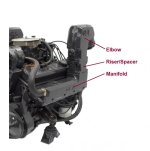So my new barr risers/ exhaust elbows showed up today, they look the same but I am not convinced. The new ones have some sort of metal sleeve inside them. I also don't see any kind of internal passages like I do on the original ones. Also can someone explain to me why the manifolds and risers share identical porting on their mating surfaces just to be blocked off? Seems so backwards lol
Shes almost ready!
old left new right




I know I will have to swap over those brass fittings. I still don't fully understand this system, seems like water being sent to dead ends? lol Its looking like i didn't even need new risers to begin with and might be easier to just use the old ones and return the new ones?
thanks in advance!
Shes almost ready!
old left new right




I know I will have to swap over those brass fittings. I still don't fully understand this system, seems like water being sent to dead ends? lol Its looking like i didn't even need new risers to begin with and might be easier to just use the old ones and return the new ones?
thanks in advance!


